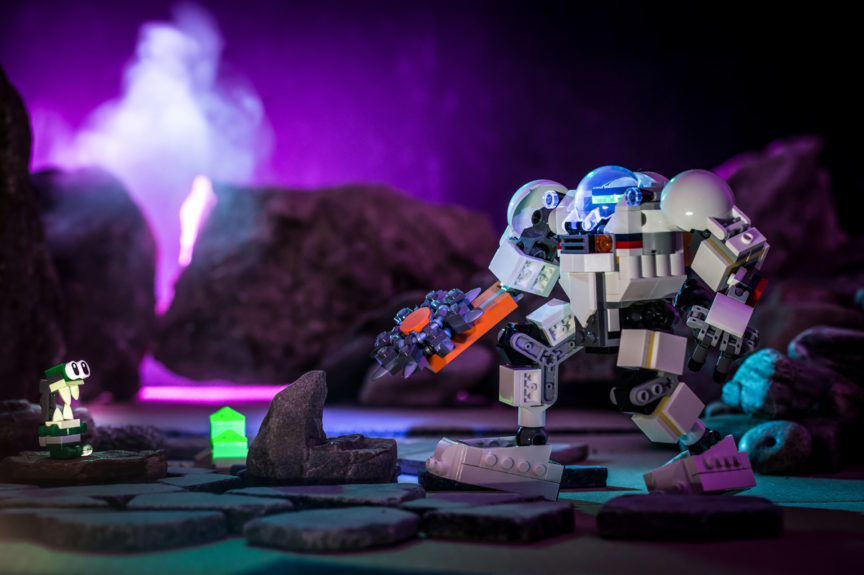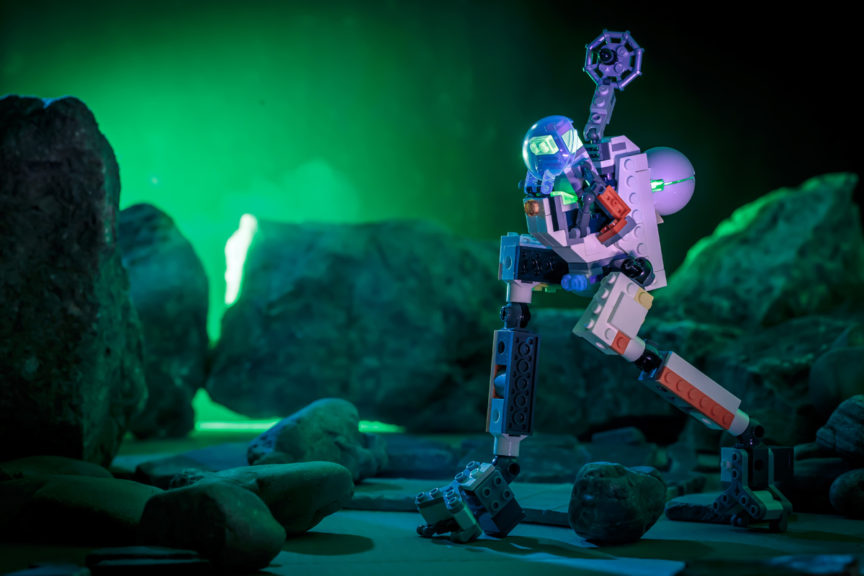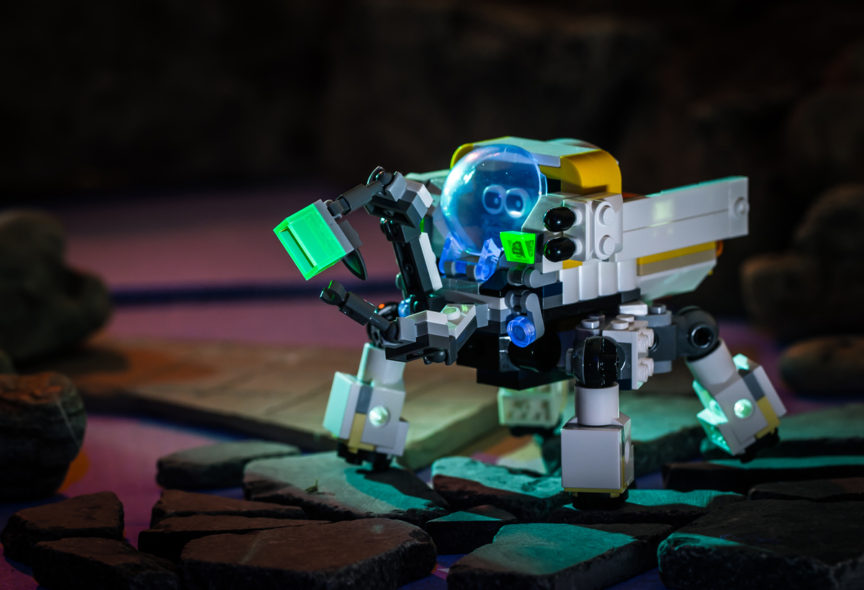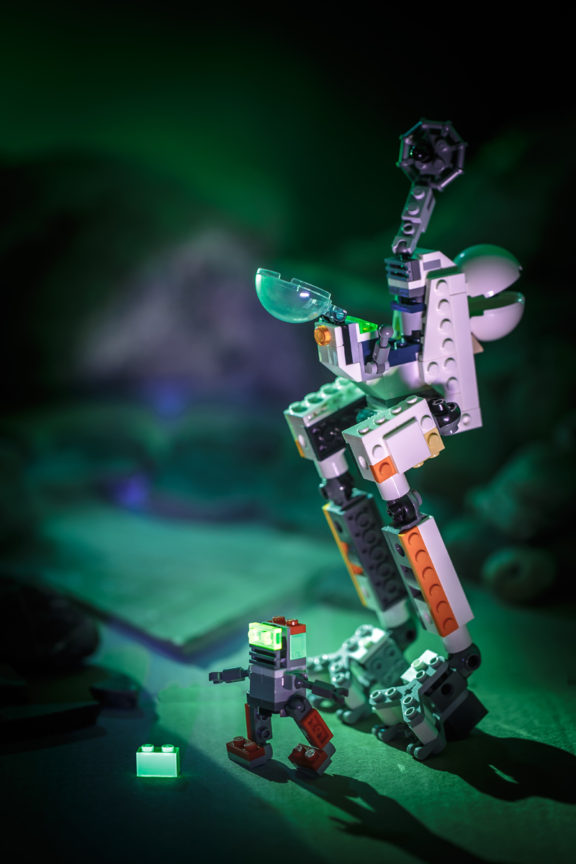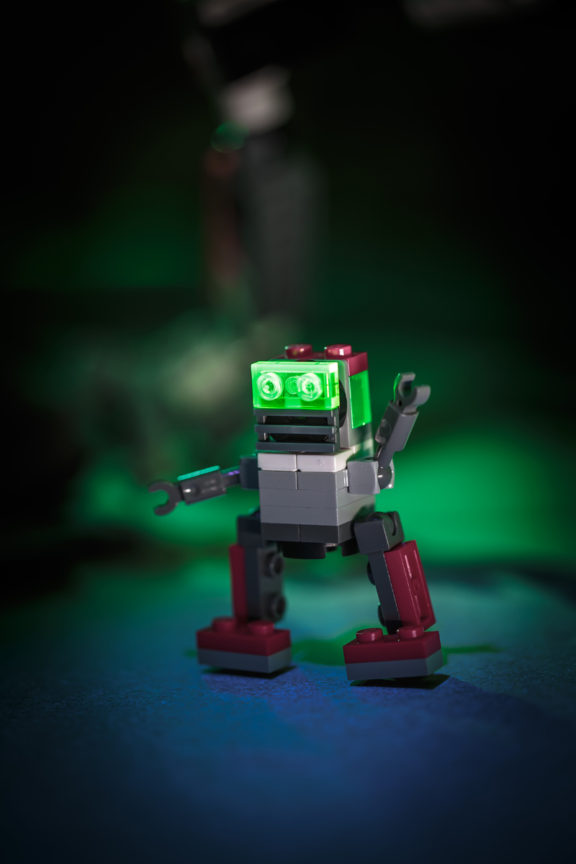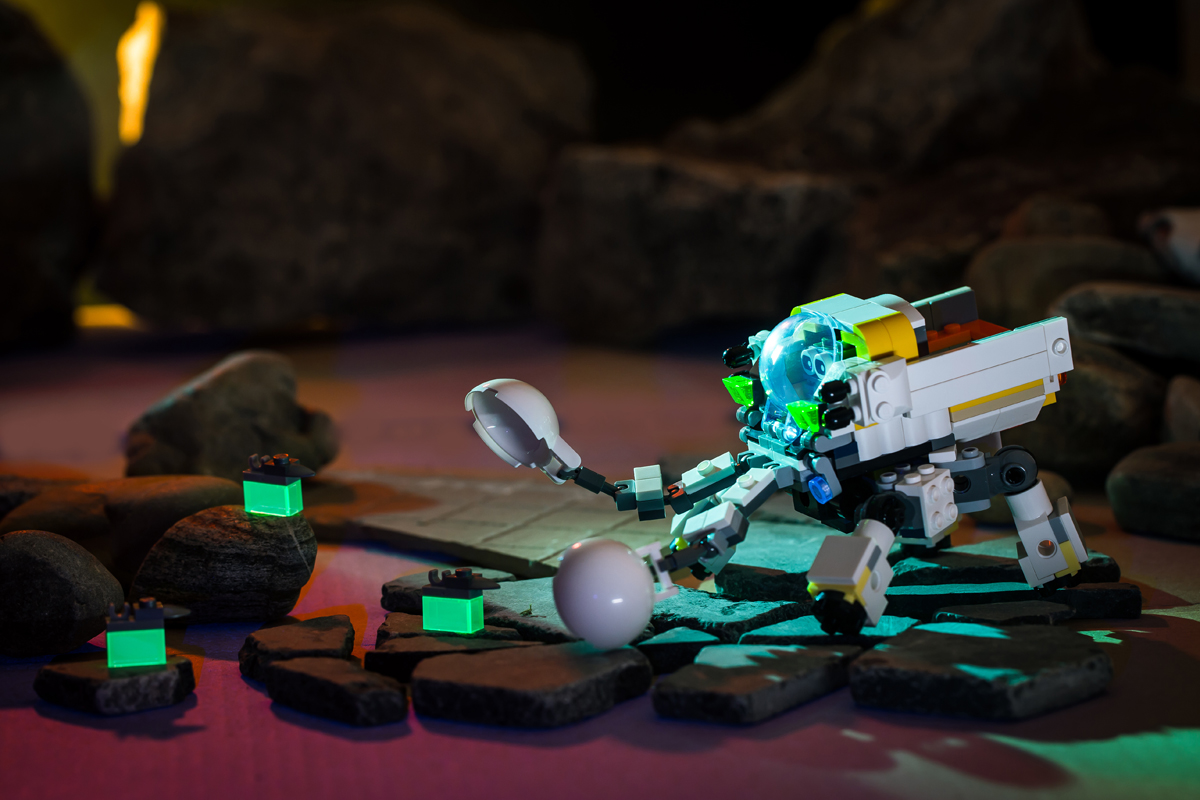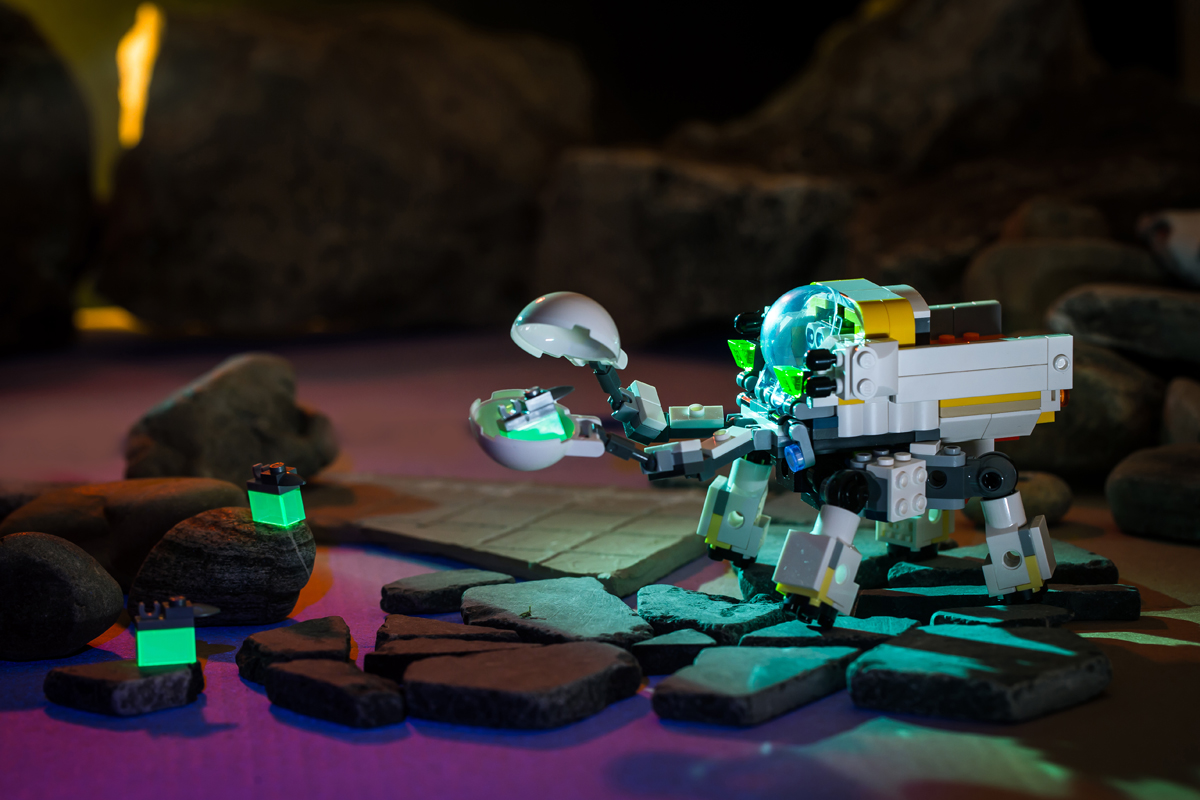When times are tough and you’re just a small big-eyed alien with impaired limb capabilities, why not call for a fully-articulated space mech?
Luckily such things do exist in all sizes and come in the upcoming LEGO Creator 3-in-1 set 31115 Space Mining Mech, to be released on March 1st.
I received this set from The LEGO Group and Brickcentral for a review and to put myself in the shoes (if they have shoes?) of three alien species and their dedicated mining mechs.
One thing I noticed when looking at those three models: the green, blue and pink transparent parts. Because the three mechs are space devices, I knew I had to make these transparent parts glow, as you will see throughout my review.
How I did that will be further detailed in a small “behind-the-scene” section.
The Space Mining Mech
Let’s start with the largest of the three builds, the Space Mining Mech. This one is the classic-looking mech, with some particularities. It is fully flexible, except at the knees as is typical for many LEGO mechs (Though not Zane’s Titan Mech).
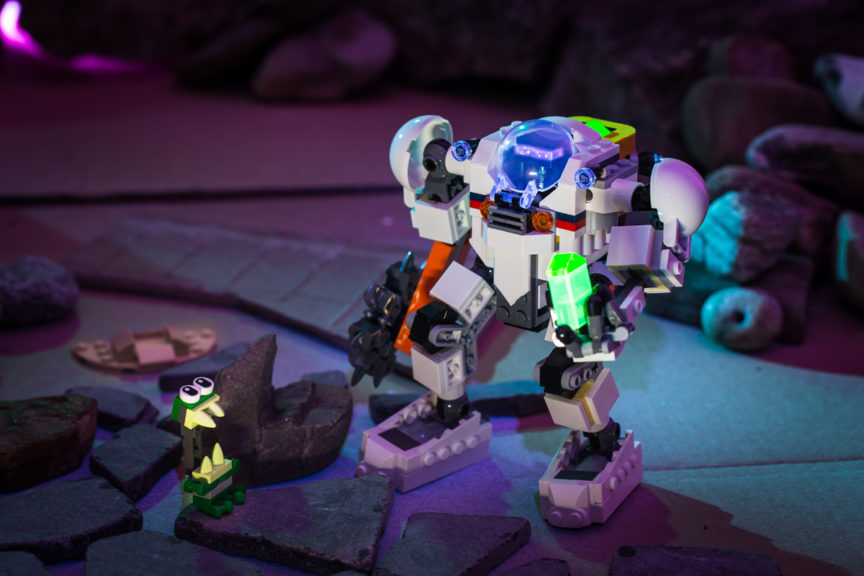
The rotating double-cylindrical joints at the shoulders, legs and ankles provide the most stability, while the smaller ball joints at the elbows and wrist allow some limited motion (and get easily removed when forcing past the range-of-motion).
There’s a rotating saw-arm on one side, and a gripping hand on the other. The mech can therefore bend very easily while cutting through rocks and grasping at rocks.
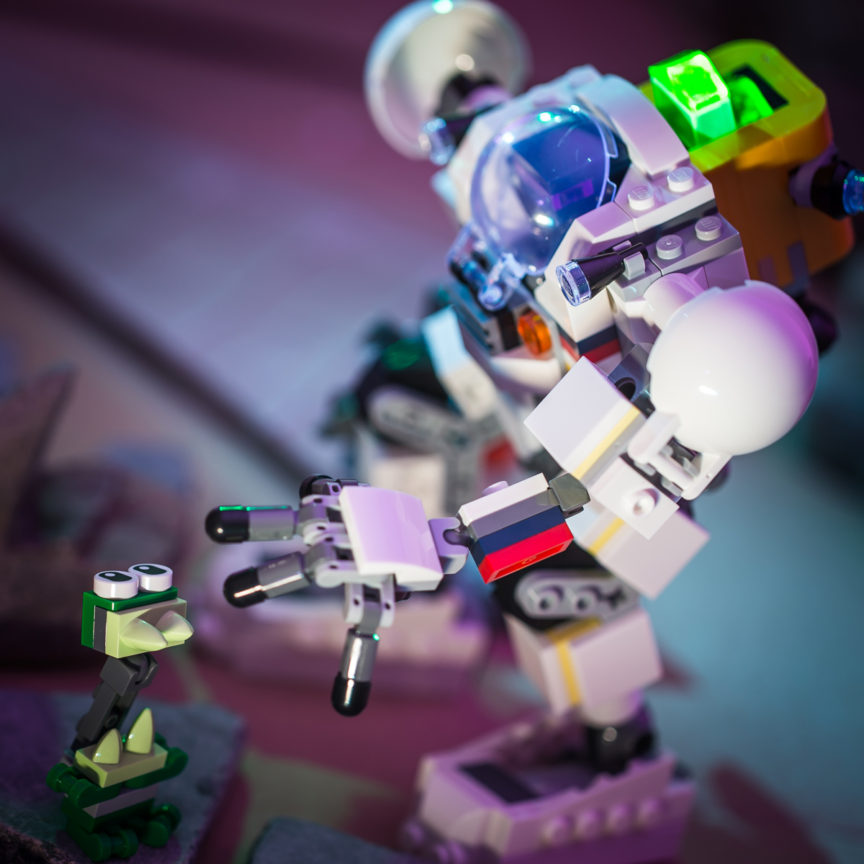
The mech is sturdy, assembled using building techniques commonly used for larger LEGO mech’s that allow playing with it like an action figure. Hence, several SNOT approaches are introduced that will challenge the younger builders and teach them some clever tricks that they’ll have fun using in their own models.
The mech comes with a backpack equipped with thrusther engines to store transparent-green minerals that can also be placed on a ground plate.
The alien figure included here is brick-built, has limited articulations and very tiny limbs, but compensates this with a very large mouth (some people are like that in the human race too, so no surprise for me here.) I liked the teeth parts used here, borrowed from the recent Hidden Side theme.
I initially thought the alien did not fit the mech, perhaps just in the backpack. This made me think it was just an inhabitant of this strange planet the space mech was sent to. But in fact, as you can see below, it is the mech’s owner.
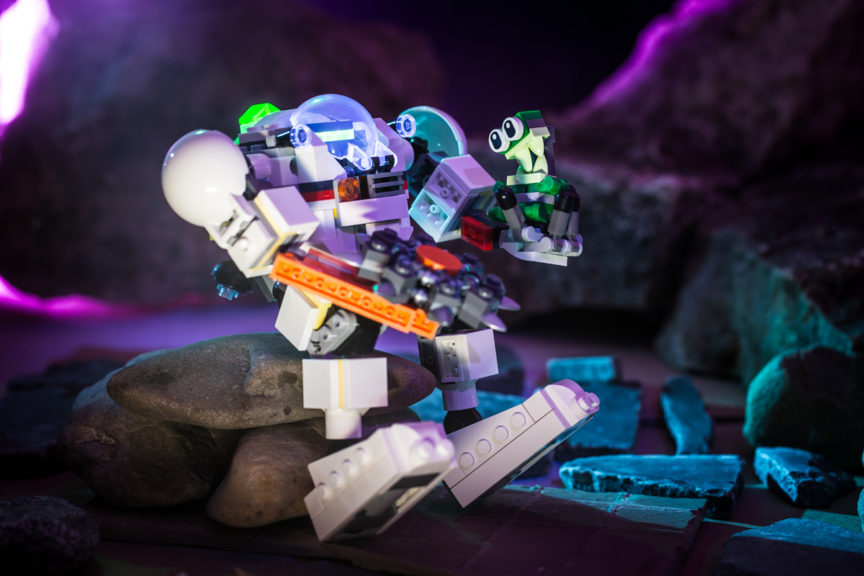
The mech comes with a “auto-pilot droid”, a nicely assembled box with two opposite “heads” with either a pink or a green transparent part. You can in fact turn it upside down and revert the mech from a “safe” to a “danger” assessment mode. Quite cool.
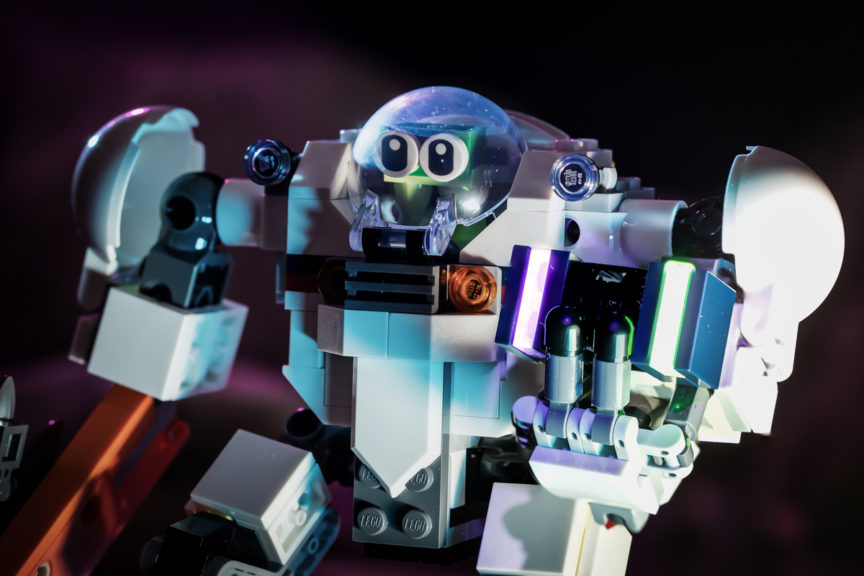
But the big-mouth alien (let’s call it, Boss) can also fit in the mech, when its lower limbs/feet are turned backwards. So there you go, no need to jump on the mech’s back to have a ride in the air. But that can work too.
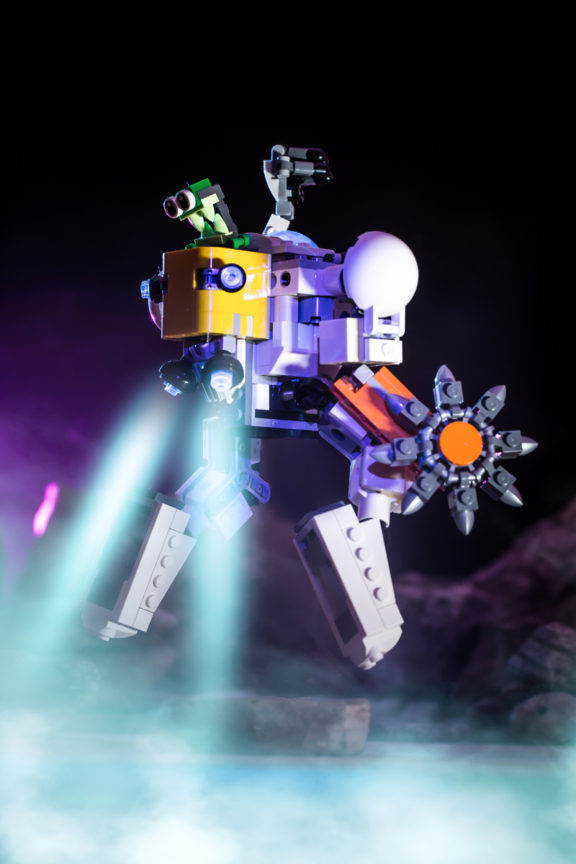
The Bipedal Mech
Some aliens don’t really care about flying. What they envy is those long-legged humans they have so long being spying on.
For them there’s a Bipedal Mech with an antena and a small round storage unit in the back that opens up slightly to let green minerals in.
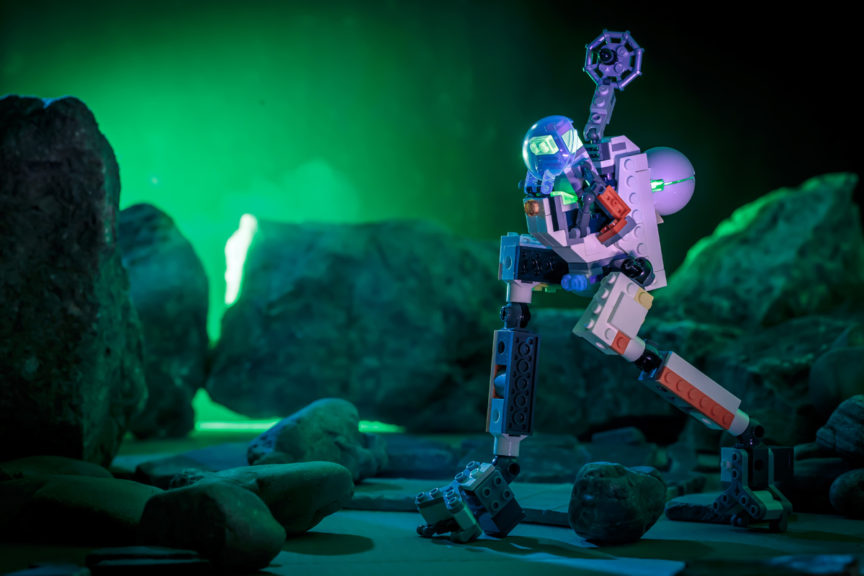
This mech is strange-looking at first. The design seems to replicate animal rear limbs, but the knee joint is flexing sideways. The mech walks by balancing on its toes and heels. It does look nice when taking poses.
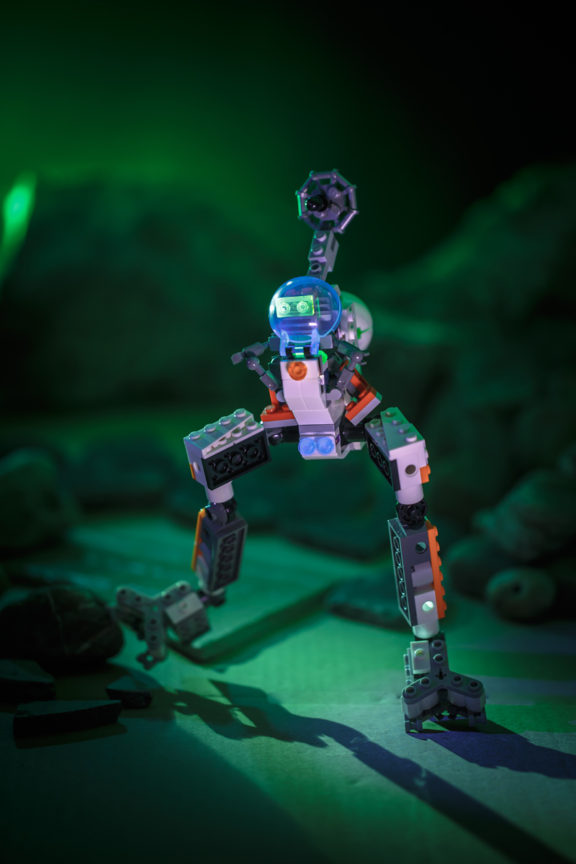
The alien, a red-legged species with a green eye visor and small hands, can easily sit in the mech “horse-riding” style. Despite limited arm motion, it can almost reach the small driving handles and has his feet laying on the mech’s thighs, like it’s using the mech as stilts. Is that useful when looking for green minerals?
Again, what’s up with the green stuff? What does it do?
The Four-Legged Mech
Here’s an answer: it grows into green, wingless alien birds!
That’s what this third model, as Four-Legged Mech, seems to be for: harvesting green wingless birds.
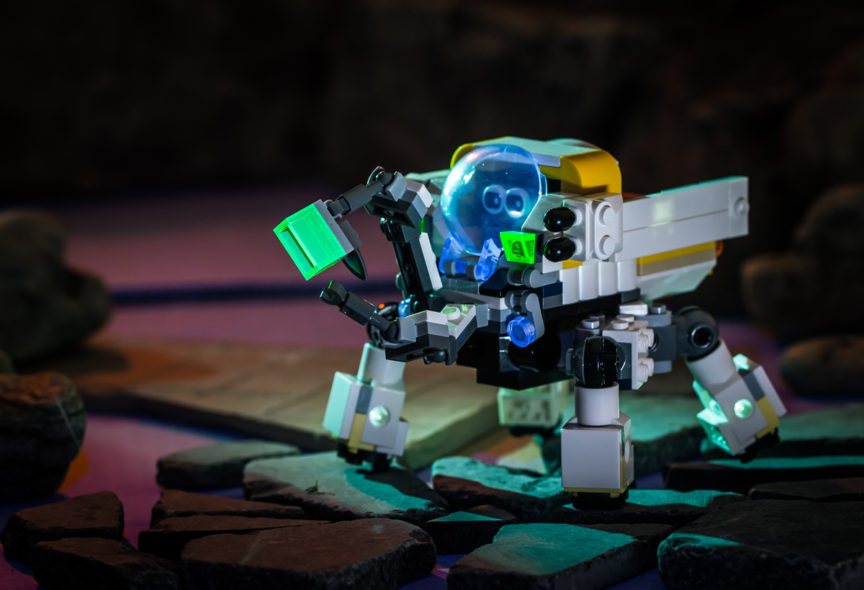
This third mech is some sort of walking vehicle, with a cockpit, and two grasping limbs up front. It also has an open storage hub at the back, where the green birds are kept. Now, since they don’t have wings I imagine it’s difficult for them to get out so the designers found no need for a hatch or a roof.
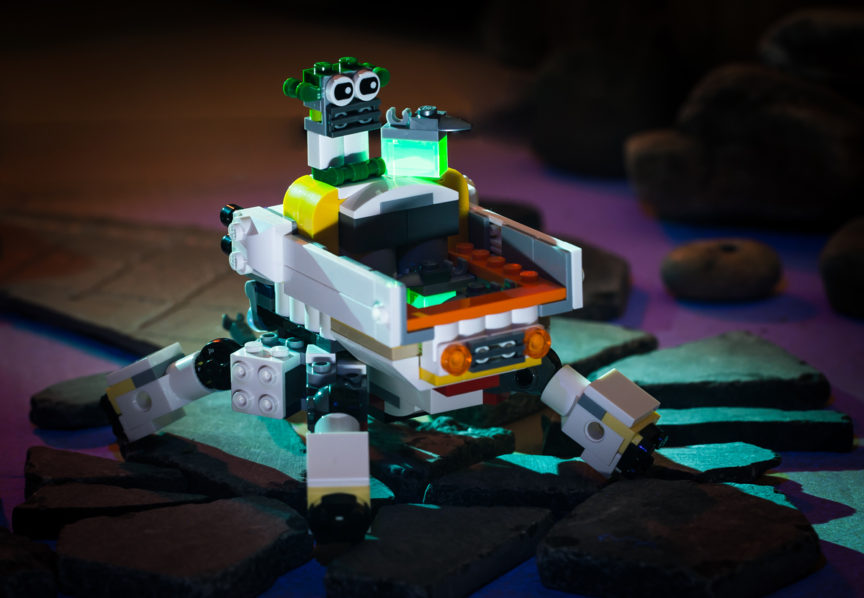
The build is very convincing and if it wasn’t for all the leftover parts, I’d assumed this was a main model. This is one of the things that could push someone into buying multiples of this set.
The mech can easily move around and grasp at rocks and birds with its front limbs. Because there are those two white round hatches in the leftover bin, I imagined a way to use those as “catching nets”. It makes it easier to scoop birds up.
The little alien fits cosily into the cockpit. It is green again this time, it must be a cousin of the first race: same big eyes and similar limbs. Its mouth is covered with some breathing mask. Do they have covid up there too?
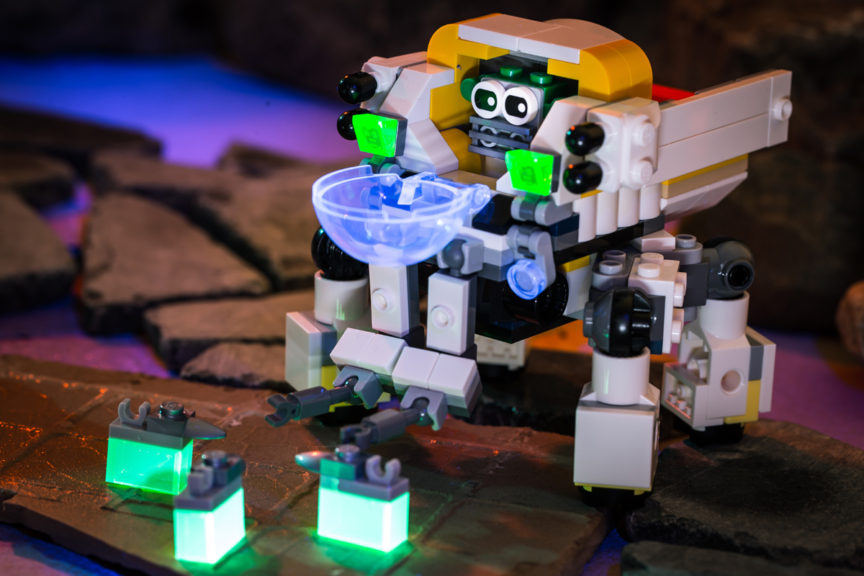
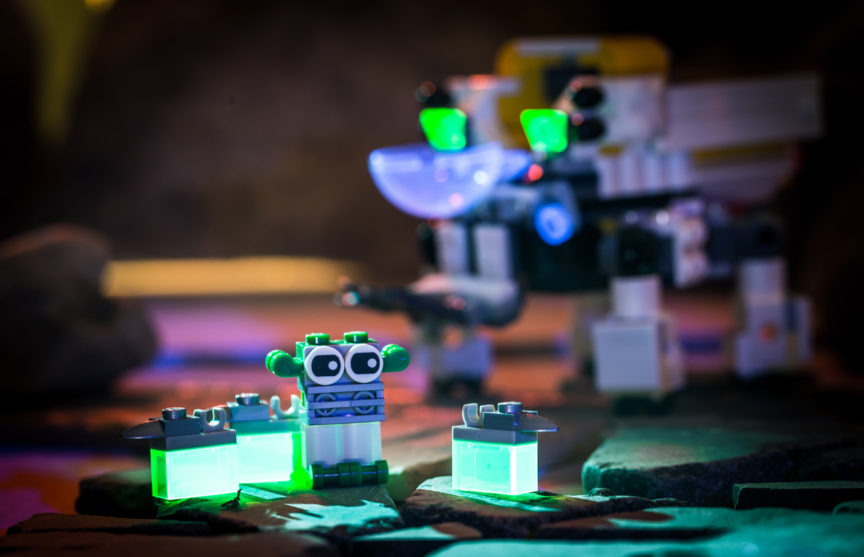
Behind-the-scenes
The pictures presented throughout this review were all done in the same setup shown below.
I started by setting up “strange planet” scenery with several colors and sizes of rocks laid on a flattened cardboard base. I placed a large matte black cardboard (1) to serve as background. This diffuses light with limited reflection.
Several lighting sources helped set up the proper tones for each mech.
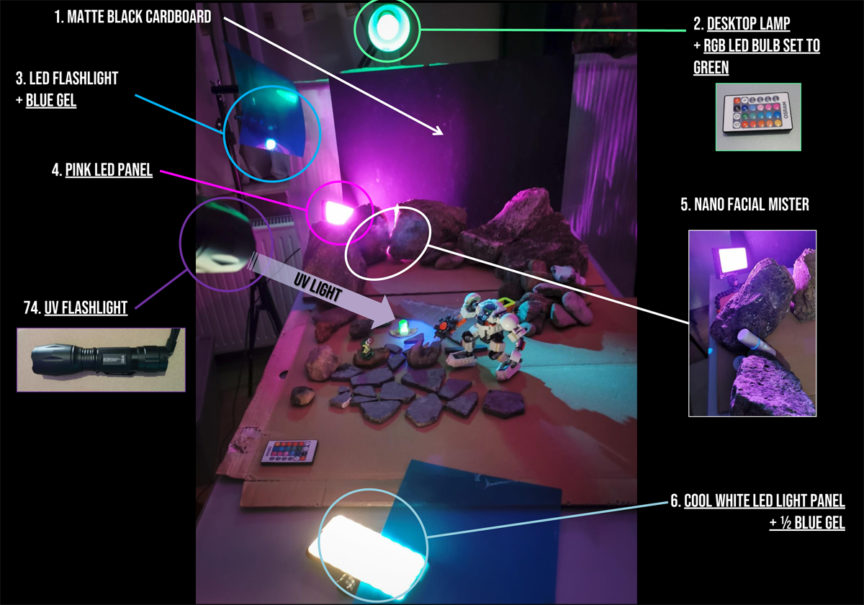
A low intensity desktop lamp with an RGB adjustable LED (2) provided lighting from above.
A powerful LED flashlight with a gel (here above a blue one) (3) was used to cast a strong hairline source directed at the scene.
An RGB-adjustable LED panel (4) placed at the back of the large rocks helped cast a color scheme to the black cardboard.
A nano facial mister (5) was squeezed between the large rocks and aimed mist so that it crossed the hairline light of the flashlight (3); this made the mist visible and helped blur part of the background.
A cool LED panel (6) at lowest intensity was placed to brighten the foreground. Fixed with a diffuser, it was also aimed vertically to avoid direct light. A gel was used to cover 1/2 of the panel to cast a different hue to the right side of the set.
To change the mood or planet for each model, I could then modify the colors of the RGB LED panel and desktop lamp, or use different color gels.
Now, that’s not really how I made the parts glow…
Let it glow, let it glow, let it glow!
You may have noticed it, in all the pictures I showed in this review, there were some parts glowing:
- The transparent cockpit and the roundish spotlights looked blusish.
- The minerals and second alien’s visor also glowed a bright green.
- The space mech blasted with blue propulsers (aside from the blasts themselves which were photoshopped).
All of these were lit with a practical effect I used for the first time in my photography: UV light.
For this I bought a small but powerful UV flashlight, with an adjustable focus (7). This allowed to cast either a strong UV light at specific isolated points of the scenes (mainly, the green mineral bricks/birds or the mechs’ hatches) or diffusing it to a larger scene and hence blending it at a lower intensity.
One problem with UV light is that it will reflect on most lighter colored elements. While it can make yellow, green and bright orange glow, it also turns white into a violet surface, which you might want to avoid unless you want a disco feel to your pictures…
I provide here a short clip that can better explain the UV light effect.
A tiny focused spot of UV will make some of the transparent and bright colored parts glow.
I could have used this trick with my last BTS shots (the Ninjago Legacy Zane’s Titan Mech 71738), especially on the ghosts which can glow with a bright green when hit by the UV light. Sadly, I received my set of flashlights just a few days too late…
Don’t hesitate to contact me for additional references on the UV flashlight.
Conclusions
Again the alternate models are built with fewer parts which serves the purpose for younger fans who want to build something without being discouraged. S
o this usually means a lot of leftover parts that people can use at will, to craft complementary scenes to these models or even beef them up. One thing I did not mention yet, is that the mechs in this set can easily accommodate minifigures as pilots.
At least, those without a huge hat or any backpack. I tested this with a Stormtrooper (what else?) but the Classic Space minifigures, once their backpack removed, will look great in those. The designers did not see fit to include any as these were meant for aliens, but I am sure a lot of kids will use them for other drivers…
Overall Score: 8/10
31115 Creator 3-in-1 Space Mining Mech has 327 pieces. The set retails for €24.99/$24.99/£24.99 and will be available on March 1st. Thanks to LEGO and Brickcentral for providing this set.
This review represents my personal opinion.

